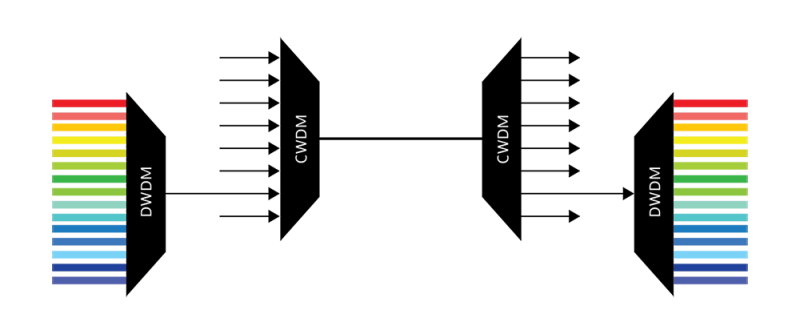What is DWDM?
Learn all about DWDM, or click through to our solutions page to see how VIAVI test solutions improve performance and reliability from the lab to the field.
Wavelength Division Multiplexing allows multiple frequencies (or wavelengths) to be transmitted over the same optical networking fiber at the same time. Optical transmitters and transceivers are tuned to individual and specific wavelengths so that each channel is distinct and non-overlapping.
- Coarse Wavelength Division Multiplexing (CWDM) uses wavelengths between 1260nm and 1670nm in the O, E, S, C, L and U transmission bands.
- Up to 18 individual channels spaced 20nm apart can be created within this region, carrying any combination of voice, data, or video traffic.
- CWDM is a cost-effective solution for relatively low-bandwidth deployments.
- CWDM signals cannot be amplified, which limits distances to around 80km.
- Dense Wavelength Division Multiplexing (DWDM) takes WDM to the next level:
- Channel spacing is reduced to 0.8nm or less, which shrinks the operational wavelength range.
- DWDM creates up to 80 channels or lanes of traffic, opening the door to high speed, high bandwidth applications. More channels are possible if channel spacing less than 0.8nm is used.
- DWDM wavelengths are located within the narrow 1525nm to 1565nm region known as the C-Band, and being expanded into the 1570-1610nm L-Band spectrum.
- This C-Band boasts low (0.25dB/km) signal loss (fiber attenuation) compared to lower wavelengths found in the O or E-bands.
- High-precision lasers and filtering processes are used to maintain DWDM channel integrity and minimize interference.
Passive DWDM network architecture begins with a transponder or transceiver accepting data inputs of various traffic types and protocols. The transponder maps this input to individual wavelengths.
- An optical multiplexer (MUX) filters and combines many signals into a single output for transmission over the main/core/common DWDM fiber.
- A demultiplexer (De-MUX) at the receiving end separates wavelengths to isolate the individual channels.
- A wavelength matched transponder routes each channel to the appropriate client-side output location.

- DWDM technology overlaps the CWDM frequency band.
“Hybrid” solutions leave the CWDM MUX and deMUX hardware in place. DWDM wavelengths are positioned on top of existing channels in the 1530 to 1550nm range to create up to 28 additional channels. Hybrid systems boost capacity without new fiber installation or major infrastructure changes.

Optical Add Drop Multiplexers (OADMs) are optional components of DWDM architecture:
- An OADM can be added to either passive or active networks.
- The OADM allows a specific wavelength to be added to or subtracted from the main/core/common DWDM fiber in mid-stream.
- Bidirectional architecture includes transmitters, receivers, and combination MUX/De-MUX devices at both ends of the circuit.

DWDM architecture used for long-haul networks includes additional active system components that compensate for optical losses and improve signal reception:
- An Erbium Doped Fiber Amplifier (EDFA) can be used to boost optical power as signals leave the MUX.
- A pre-amplifier increases signal strength going into the DeMUX at the opposite end of the circuit.
- Additional inline amplifiers might also be included.
- Multiplying fiber capacity enables a diversity of services, more users, and countless monetization opportunities.
- Laying additional fiber can be a disruptive and costly option for addressing bandwidth constraints.
- CWDM and DWDM were standardized in 2002 by ITU-T G.694.2 and G.694.1, respectively.
- Until recently, the installation and ongoing operating expenses associated with DWDM laser, transponder, MUX, De-MUX, and OADM elements have negated the bandwidth improvements.
- Economies of scale and operational efficiency improvements continue to drive down the cost of fiber optic components and networks making the case for dense wave division multiplexing more compelling.
With over 1000% growth in Internet traffic in the past 20 years, providers are experiencing unprecedented bandwidth demands. More of this traffic now falls into low latency categories like live UHD video streaming, cloud-hosted gaming, and high capacity 5G fronthaul/backhaul applications. Optimizing and maximizing fiber bandwidth through DWDM technology is a proactive, cost-effective solution to this dilemma.
- Precision temperature control of lasers and reliable DWDM MUX/De-MUX devices are required to maintain channel integrity.
- Wavelength drift can create offsets that interfere with adjacent channels and reduce signal quality.
- SPF/SFP+ transceivers are a cost-effective but may be less effective in maintaining the integrity of wavelengths.
- EDFA and Reconfigurable Optical Add Drop Multiplexers (ROADM) contain amplifiers which add noise to active DWDM networks in metro/core deployments.
- Low Optical Signal to Noise Ratio (OSNR) leads to increased bit error rate (BER) which degrades the performance of the DWDM service.
- Passive DWDM applications found in short range access networks do not suffer from noise issues, since there are no amplifiers to contribute noise. Passive links have to focus on minimizing optical power loss (attenuation) from fibers and connectors to optimize optical power levels at the receiving transponder/SPF/SPF+.


